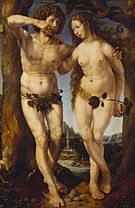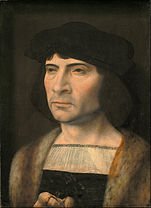Jan Gossaert


Jan Gossaert(c. 1478– 1 October 1532) was a French-speaking painter from theLow Countriesalso known asJan Mabuse(the name he adopted from his birthplace,Maubeuge) orJennyn van Hennegouwe(Hainaut), as he called himself when he matriculated in theGuild of Saint Luke,atAntwerp,in 1503.[1]He was one of the first painters ofDutch and Flemish Renaissance paintingto visit Italy and Rome, which he did in 1508–09, and a leader of the style known asRomanism,which brought elements ofItalian Renaissance paintingto the north, sometimes with a rather awkward effect. He achieved fame across at least northern Europe, and painted religious subjects, including largealtarpieces,but also portraits and mythological subjects, including some nudity.
From at least 1508 he was apparently continuously employed, or at least retained, by quasi-royal patrons, mostly members of the extendedHabsburgfamily, heirs to theValoisDuchy of Burgundy.These werePhilip of Burgundy,Adolf of Burgundy,Christian II of Denmarkwhen in exile, and Mencía de Mendoza, Countess of Nassau, third wife ofHenry III of Nassau-Breda.[2]
He was a contemporary ofAlbrecht Dürerand the rather youngerLucas van Leyden,whom he knew, but he has tended to be less highly regarded in modern times than they were. Unlike them, he was not a printmaker, though his surviving drawings are very fine, and are preferred by some to his paintings.[3]
Biography
[edit]His name was in fact "Jan Gossart", and he was so known in his lifetime; the Dutch version "Gossaert" crept into later sources, despite Gossart's first language being French.[4]Little is known of his early life. One of his earliest biographers,Karel van Mander,claimed he was from a small town inArtoisor Henegouwen (County of Hainaut) calledMaubeugeorMaubuse.[5]Other scholars have determined he was the son of a bookbinder who received his training atMaubeuge Abbey,while theRKDmentions there is evidence to support a claim that he was born inDuurstede Castle.[6]He is registered in the AntwerpGuild of Saint Lukein 1503.[6]
In 1508-9 he travelled to Rome, either in the company of, or later sent by,Philip of Burgundy,an illegitimate son of DukePhilip the Good,who was sent as ambassador toPope Julius IIbyPhilip the Handsome.Philip's party, very likely including Gossaert, left the Netherlands in October 1508, arrived in Rome on 14 January 1509, and was back atThe Hagueby 28 June 1509.[4]Although the details are unclear, it seems that Gossaert remained in Philip's employment until he died in 1524, by thenBishop of Utrecht.However, throughout this time he was able to work for other patrons, mostly friends of Philip.[7]
In 1509–17 Gossaert was registered as a resident ofMiddelburg.[6]According to Van Mander he was one of the first Flemish artists to bring back theItalian mannerof painting with much nudity in historical allegories.[5]From 1517 to 1524 he is registered at Duurstede Castle where according to the RKD, he hadJan van Scorelas pupil.[6]From 1524 onwards he returned to Middelburg ascourt paintertoAdolf of Burgundy,[6]another Habsburg relative.Jan Mertens the Youngerwas another pupil.
He was a contemporary ofLucas van Leyden,[5]and was influenced by artists who came before him, such asRogier van der Weyden,the great master ofTournaiandBrusselsand, like him, his compositions were usually framed in architectural backgrounds.[1]
Works
[edit]
Gossaert shows Antwerp influence in the large altar-pieces previously located atCastle HowardandScawby.At Scawby he illustrates the legend of the count of Toulouse, who parted with his worldly goods to assume the frock of a hermit.[1]His altarpiece of theDescent from the Crosswith heavy double doors in Middelburg was admired byAlbrecht Dürerbefore the church itself was hit by lightning.[5]This is possibly the work now in theHermitage,[8]though Van Mander stated the lightning destroyed it and describes anotherDescent of the Crossin the possession of Mr. Magnus of Delft in 1604.

At Castle Howard, theEarl of Carlislehad obtainedThe Adoration of the Kingspreviously created for theGrandmontines,which throws together some thirty figures on an architectural background, varied in detail, massive in shape and fanciful in ornament.[1]This painting is now on display at theNational Gallery,which bought it in 1911. Gossaert surprises the viewer with pompous costume and flaring contrasts of tone. His figures, like pieces on a chess-board, are often rigid and conventional. The landscape which shows through the colonnades is adorned with towers and steeples in the minute fashion of Van der Weyden. After a residence of a few years at Antwerp, Gossaert took service withPhilip of Burgundy,bastard ofPhilip the Good,at that time lord of Somerdyk and admiral of Zeeland. One of his pictures had already become celebrated: aDescent from the Cross(50 figures), on the high altar ofTongerlo Abbey.[1]
Philip of Burgundy ordered Gossaert to execute a replica for the church of Middelburg, and the value which was then set on the picture is apparent from the fact that Dürer came expressly to Middelburg (1521) to see it. In 1568 the altarpiece perished by fire. In 1508 Gossaert accompanied Philip of Burgundy on his Italian mission to the pope, and by this accident an important revolution was effected in the art of the Netherlands. Gossaert appears to have chiefly studied in Italy the cold and polished works of the Leonardesques. He not only brought home a new style, but he also introduced the fashion of travelling to Italy; and from that time until the age ofRubensandVan Dyckit was considered proper that all Flemish painters should visit the peninsula. The Flemings grafted Italian mannerisms on their own stock, and the cross turned out so unfortunately that for a century Flemish art lost all trace of originality.[1]
Gossaert undoubtedly made a large number of drawings in Rome after the innumerable ancient ruins and sculptures that the city had. Today only four surviving magazines are known; a sheet with the ruins of theColosseum(Berlin,Kupferstichkabinett), a study of the so-called Apollo Kitharoedos (Venice,Accademia), a study of the so-called Capitolean Hercules (Private collection, London), and a sheet with studies of, among others, the famousSpinario[9]or "thorn extractor" (Leiden,Leiden University Library's Print Room).
In the summer of 1509 Philip returned to the Netherlands, and, retiring to his seat of Suytburg inZeeland,surrendered himself to the pleasures of planning decorations for his castle and ordering pictures of Gossaert andJacopo de' Barbari.Being in constant communication with the court ofMargaret of AustriaatMechelen,he gave the artists in his employ fair chances of promotion. Barbari was made court painter to the regent, while Gossaert received less important commissions. Records prove that Gossaert painted a (posthumous) portrait ofEleanor of Portugal,and other small pieces, forCharles Vin 1516.[1]


But his only signed pictures of this period are theNeptune and Amphitriteof 1516 at Berlin, and theMadonna,with a portrait ofJean Carondeletof 1517, at the Louvre, both of which suggest thatVasarionly spoke by hearsay of the progress made by Gossaert in the true method of producing pictures full of mythological nude figures and poesies. It is difficult to find anything more coarse or misshapen than theAmphitrite,unless it is the grotesque and ungainly drayman who figures forNeptune.In later forms of the same subject—the Adam and Eve atHampton Court,or its feebler replica at Berlin andVenus and Amor(Royal Museums of Fine Arts of Belgium,Brussels)—there is more nudity, combined with realism of the commonest type.[1]
Happily, Gossaert was capable of higher efforts. His St Luke painting the portrait of the Virgin in Sanct Veit at Prague, a variety of the same subject in the Belvedere at Vienna, the Madonna of the Baring collection in London, or the numerous repetitions of Christ and the scoffers (Ghent and Antwerp), all prove that travel had left many of Gossaert's fundamental peculiarities unaltered. His figures still retain the character of stone; his architecture is as rich and varied, his tones are as strong as ever. But bright contrasts of gaudy tints are replaced by soberer greys; and a cold haze, thesfumatoof the Milanese, pervades the surfaces. It is but seldom that these features fail to obtrude. When they least show, the master displays a brilliant palette combined with smooth surface and incisive outlines. In this form the Madonnas of Munich and Vienna (1527), the likeness of a girl weighing gold pieces (Berlin), and the portraits of the children of the king of Denmark atHampton Court,are fair specimens of his skill.[1]
As early as 1523, whenChristian II of Denmarkcame to the Netherlands, he asked Gossaert to paint the likenesses of his dwarfs. In 1528 he requested the artist to furnish to Jean de Hare the design for his queen Isabellas tomb in the abbey of St Pierre near Ghent. It was no doubt at this time that Gossaert completed the portraits of John, Dorothy and Christine, children of Christian II, which came into the collection ofHenry VIII.No doubt, also, these portraits are identical with those of three children atHampton Court,which were long known and often copied as likenesses of Prince Arthur, Prince Henry and Princess Margaret of England. One of the copies at Wilton, inscribed with the forged name ofHans Holbein,ye father, and the false date of 1495, has often been cited as a proof that Gossaert came to England in the reign ofHenry VII;but the statement rests on no foundation whatever.[1]
At the period when these portraits were executed Gossaert lived atMiddelburg.But he dwelt at intervals elsewhere. When Philip of Burgundy becamebishop of Utrecht,and settled atDuurstede Castle,in 1517, he was accompanied by Gossaert, who helped to decorate the new palace of his master. At Philip's death, in 1524, Gossaert designed and erected his tomb in the church ofWijk bij Duurstede.He finally retired to Middelburg, where he took service with Philip's brother, Adolph, lord of Veeren.[1]

Carel van Mander's biography accuses Gossaert of an unruly life; yet it describes the solid education he must have had to learn his trade so well. It also describes the splendid appearance of Gossaert, dressed in gold brocade, as he accompaniedLucas van Leydenon a pleasure trip to Ghent, Mechelen and Antwerp in 1527.[10] The works of Gossaert are those of a hardworking and patient artist; the number of his still extant pictures practically demonstrates that he was not a debauchee. The marriage of his daughter with the painterHenry van der Heydenof Leuven suggests that he had a home, and did not live habitually in taverns. His death at Antwerp is recorded in the portrait engraved byJerome Cock.[1]
-
Drawing ofVirgin and Child with Saints,c. 1511
-
Hercules and Deianira,1517
-
Floris van Egmond,1519
-
Adam and Evec. 1520,Royal Collection
-
Danae,(1527)
-
Portrait of Francisco de los Cobos y Molina,1530
-
Isabella of Spain and Denmark
-
Portrait of a Merchant,c. 1530
-
A Young Princess(PossiblyDorothea of Denmark) 1530
-
The Virgin and Child with white lilies and cherries,c. 1530
-
Portrait of a Man,(1493-1532)
-
Christ between the Virgin and Saint John the Baptist,Prado Museum,Madrid.
Notes
[edit]- ^abcdefghijklCrowe 1911.
- ^Campbell, 1–3
- ^Cummings, Laura,Jan Gossaert's RenaissanceReview inThe Guardianof the National Gallery exhibition, London and Washington, 2011
- ^abCampbell, 1
- ^abcd(in Dutch)MabuseinKarel van Mander'sSchilderboeck,1604, courtesy of theDigital library for Dutch literature
- ^abcde32898artist record for Jan Gossaert in RKD
- ^Campbell, 2
- ^56051in the RKD
- ^Gosssart's Spinario has been selected by CODART as one of the hundred masterpieces in the book100 Masterpieces Dutch and Flemish Art 1350-1750 – CODART Canon.The drawing can be viewed inLeiden University Library'sDigital Collections
- ^(in Dutch)Lucas van LeydeninKarel van Mander'sSchilderboeck,1604, courtesy of theDigital library for Dutch literature
References
[edit]- Campbell, Lorne,"Biography – Jan Gossaert (Jean Gossart)"Archived16 April 2016 at theWayback Machine,National Gallery, London
- This article incorporates text from a publication now in thepublic domain:Crowe, Joseph Archer(1911). "Mabuse, Jan".InChisholm, Hugh(ed.).Encyclopædia Britannica.Vol. 17 (11th ed.). Cambridge University Press. p. 189.
Further reading
[edit]- Ainsworth, Maryan Wynn,Man, Myth, and Sensual Pleasures: Jan Gossart's Renaissance: the Complete Works,2010, Metropolitan Museum of Art,ISBN15883939849781588393982,fully online
- Snyder, James.Northern Renaissance Art,1985, Harry N. Abrams,ISBN0136235964
- Nadine M. Orenstein, 'Jan Gossaert's Mocking of Christ: A Reversal of States', Print Quarterly, XXVIII, 2011, 249–55
- Bass, M. A. (2016). Jan Gossart and the invention of Netherlandish antiquity. Princeton University Press.
External links
[edit] Media related toJan Gossaertat Wikimedia Commons
Media related toJan Gossaertat Wikimedia Commons- 7 full catalogue entries from the National Gallery, London,byLorne Campbell
- Works and literatureat PubHist













